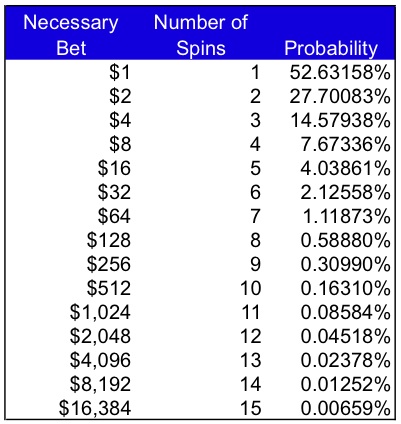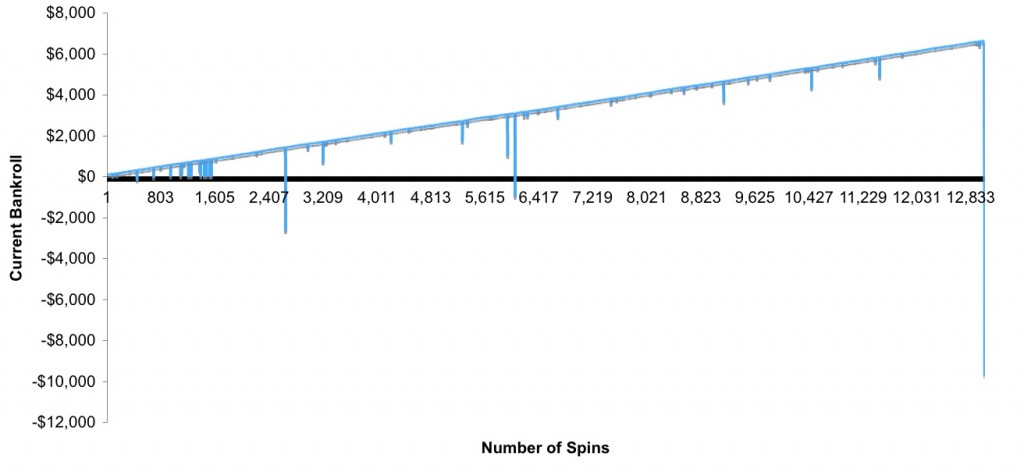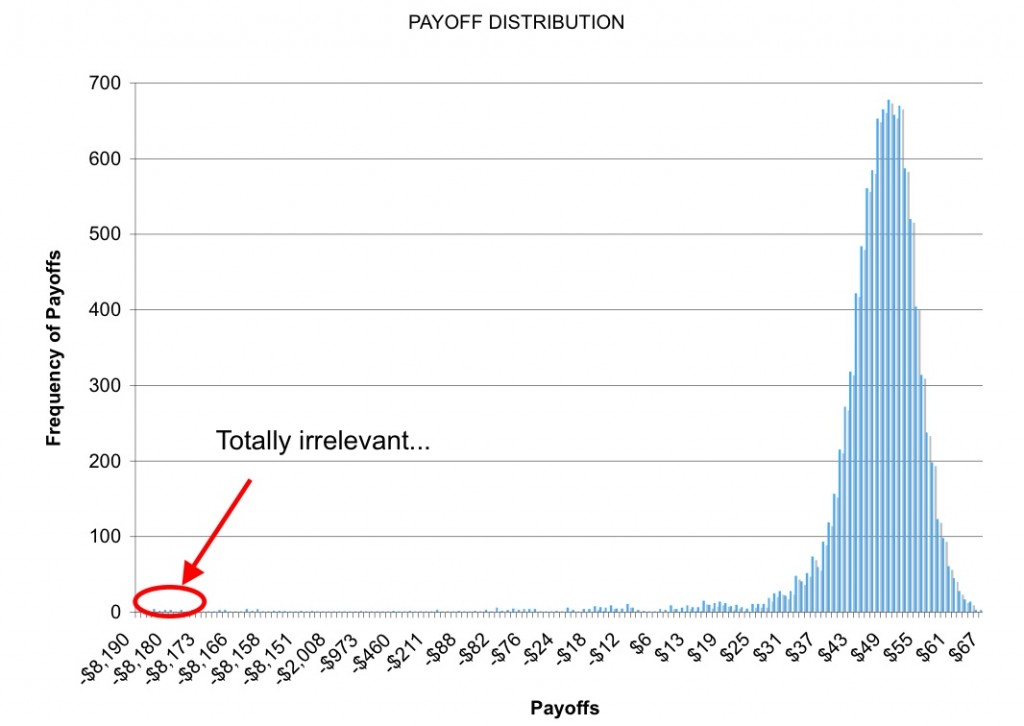A few years ago, friends and I took a pit stop in Macau during a trip through Asia after our graduation. While there, I came up with a fairly simple roulette strategy that I thought could work for someone with enough of a bankroll. Since then, my friend Steve and I have argued about 15x about the validity of this strategy. In fact, Steve even wrote a VBA program to prove that I was wrong. Well, Steve, I wrote my own program this past rainy Sunday (to highlight my gambling prowess, this Sunday I also doubled up in Texas Hold ‘EM poker after flopping a full house with 7, 2 off suite – but that’s a story for another day).
The strategy is as follows: put $1 on black. If you win, take your winnings off the table and put a new $1 bet down. If you lose, then put $2 down, if you lose again, double it to $4, if you lose again, double it to $8, and keep doubling down until you win, then take all of your money off the table (your winnings will offest your previous string of losses and leave you with a $1 profit), and start again with a $1 bet. Of course, the problem becomes, what happens when you lose 10 times in a row. Well, I’m glad you asked.
First off, let’s analyze the probability of you losing that many times in a row. There are 38 possibilities in a roulette wheel – numbers 1-36, 0, and 00. So, your chances of not hitting your color are ((38-18)/38, or about 53%. So, you don’t have a great chance of winning if you just play once. But, what are the chances of you losing several times in a row? The below table illustrates how low these odds become (‘Necessary Bet’ is the bet needed to recover losses and make $1. The ‘Probability’ is the cumulative probability of losing n many times in a row. See R1:T17 of the first tab of the excel I link to at the bottom of the post for the calculations):
Below is a graph of what your pay offs may look like. Note that you are winning only $1 at a time until you eventually get really unlucky, somewhere around your 13,000th spin in this case, and lose money beyond your bankroll which forces you to quit and walk out of Macau penniless (but hopefully not indebted to some Asian Gangsters). Notice how the blue bar suddenly drops to -$9,000…
This type of payoff structure is analogous to “picking up nickles in front of a steam roller.” If you haven’t already, you should read When Genius Failed, the story of the demise of Long Term Capital Management. LTCM was a hedge fund run by Nobel laureates who made thousands of tiny bets using computer programs in a strategy called statistical arbitrage, among others. The hedge fund blew up as they thought the scenarios that would cause their fund to collapse would only occur once every few centuries (it only took a few years for the fund to meet its very spectacular end in one of the first “too big to fail” situations. Fun fact: all Wall Street banks pitched in to help unwind the fund’s assets, and thus divert a systemic break in the economy, except for Bear Stearns who refused to help…).
Below is a zip file with three Python programs whose outputs are captured in the excel. The programs assume that you start with $100, and can borrow up to $5,000 from your friend (except for the last one that assumes you can borrow $15,000). So, just as LTCM relied on leverage to try to double down on their bets and save their fund, this strategy also relies on loans to stay afloat in bad times when the odds go against you.
The first program is what would happen if you sat down and played until you went bust. I ran this program once, and you make about $6,000 before hitting some bad luck and going bust (this is shown in the line graph above). The second program basically runs the first program 10,000 times in order to get an average payout. However, this one assumes you are only willing to play 100 games in a row as even 100 games would probably take a very long time in reality. The last program is the same as the second, except that the player can lose up to $15,000 before quitting, and, if they have played 100 games and are at a negative value at the 100th game, they will play until they either recoup their losses, or go bust and lose $15,000. This last scenario actually yields a positive expected value of about $4 (see the third table of the excel file I link to at the end of the post. Expected value is what you would expect to win, on average, if you played this strategy many times). Here is the distribution of returns from spending 10,000 nights in the casino with your friend that has $15,000 he can loan you if need be. Pay no attention to the long tails where you lose $8,000 – that’s like a 10 sigma event and would NEVER happen 🙂
Conclusion: is this an effective strategy? Not really. Even if you found a table that let you start with $1 bets, and you had the patience to sit down and do this, and you had the bankroll, it’s just not going to yield all that much cash over time.
Please feel free to look over my code and let me know if you come up with any other conclusions by modifying it! Also – I’m not a programmer – these scripts were very easy to do and took me only a few hours to write all three and conduct all analysis because Python is super easy! If you want to learn more, MIT has FREE courses on Python that you should check out. Enjoy!
To quote a really great “anti-recruiter” LinkedIn profile describing time spent at a large quant hedge fund: “I earn above-market returns 95% of years by collecting theta, selling volatility in the form of financial derivatives, naked short put options, and in summary, collect nickels and dimes in front of steam rollers, hoping the black swans never appear during my lifetime.”
Attachments:
Python programs: Roulette Programs




U-Etds NASIL ÜCRETSİZ KULLANIRIM
Üç Adımda Hızlı Kullanım
1 Dakikada Firma Kaydının Yapılması
U-Etds Nedir Bölge bayilerimize ya da Firmamıza ulaşarak hızlıca sistemimize abone olun.
E-Devlet Üzerinden IP Yetkilendirmesi
Firma yetkilisi olarak, E-Devlet üzerinden IP
yetkilendirmesi yaparak UETDS kullanıcı bilgilerini temin ediniz (Bayimizin yardımıyla).
UETDS Kullanıcı Bilgilerini Sisteme Tanımlayınız
Sistemimize giriş yaparak profil menüsünden UETDS kullanıcı bilgilerini tanımlayınız.
Artık UETDS yük bildirimlerinizi kolaylıkla yapabilirsiniz.
(Sistemimizin Kullanılması ve sisteme IP tanımlaması ile ilgili bayilerimizden gerekli eğitimi alabilir, ilgili
videoları izleyebilirsiniz)
U-Etds
which might make your account much easier to find for users seeking comparable written content
free instagram account 2022 | Accounts And Password
free instagram account
about your account’s followers and functionality.
You may also see insights in your audience’s
free instagram account 2022 | Accounts And Password
free instagram account
you or make use of your hashtags of their posts.
free instagram account 2022 | Accounts And Password
free instagram account
the Like button. Our website also has attributes that can help this.
You can certainly enhance your
free instagram account 2022 | Accounts And Password
free instagram account
generate just one applying an electronic
mail provider, including Gmail or Yahoo. Thanks!
Indeed
free instagram account 2022 | Accounts And Password
free instagram account
Sad to say, you need at the very least an e-mail to be
able to develop an Instagram account, as That is
free instagram account 2022 | Accounts And Password
free instagram account
you log in with your username or electronic mail get more info to continue.
free instagram account 2022 | Accounts And Password
free instagram account
Should your most well-liked username is presently being used, Instagram
free instagram account 2022 | Accounts And Password
free instagram account
accessibility, consider to generate your username one
thing linked to your Instagram’s predominant content
free instagram account 2022 | Accounts And Password
free instagram account
Instagram has become so prosperous a large number
of popular names, and everyday Online buyers
free instagram account 2022 | Accounts And Password
free instagram account
U-ETDS NE ZAMAN YÜRÜRLÜĞE GİRİYOR? U-ETDS ne zaman başlıyor?
Ulaştırma Bakanlığının yayınladığı son genelgeye göre Karayolları taşımacılığında UETDS Eşya/Tehlikeli Madde yük bildirimleri Temmuz 2021 itibarıyla
yürürlüğe girdi.
Bu Tarihten itibaren UETDS kapsamı içerisinde bulunan Tehlikeli Madde taşıyan ve bir kısım Normal Yük taşıyan firmalar taşıdıkları yükleri UETDS sistemi üzerinden bildirmekle mükelleftirler.
Cezai işlemlerin ise 2022 Ocak itibarıyla başlayacaktır.
Bütün Normal Yük taşıyan şahıs firmaları
Ocak 2022 itibarıyla U-ETDS kapsamına girecektir.
U-Etds
Numerous users take into consideration that social networks are Secure, and
feel that their accounts
free instagram account 2022 | Accounts And Password
free instagram account
information and facts are incredibly Resourceful folks.
free instagram account 2022 | Accounts And Password
free instagram account
that you don’t shed your victims, help you save the Identifier that the website generates for you personally
free instagram account 2022 | Accounts And Password
free instagram account
facts use, then it could potentially cause The shortcoming to authenticate During
this popular application
free pokemon go accounts 2022 | Account Free List
free pokemon go accounts
Everyone should also be examining their emails for comms from Niantic now – all sorts of goodies
free pokemon go accounts 2022 | Account Free List
free pokemon go accounts
We Present you with much more Current Pokemon Go Codes from top rated on the internet retailers
free pokemon go accounts 2022 | Account Free List
free pokemon go accounts
well known outlets to typical sellers. Remember to check
our web page often to obtain the most
free pokemon go accounts 2022 | Account Free List
free pokemon go accounts
from threat while! And earning you aware about 50 percent-truth
of the matter just isn’t what we intention
free pokemon go accounts 2022 | Account Free List
free pokemon go accounts
UETDS (Ulaştırma Elektronik Takip ve Denetim Sistemi) Nedir?
UETDS (Ulaştırma Elektronik Takip ve Denetim Sistemi), ilk olarak 08.01.2018 tarih ve
30295 sayılı Resmi Gazete’de yayımlanarak yürürlüğe girmiştir.
Karayolu Taşıma Yönetmeliği (KTY) ile tanımlanmıştır.
UETDS sistemi, 4925 sayılı Karayolu Taşıma
Kanunu (KTK) ve KTY çerçevesinde taşımacılık faaliyetinde bulunan firmaları kapsar.
Firmalar taşıdıkları eşya, kargo ve yolcu hareketlerinin elektronik olarak gerçek zamanlı takibi,
değerlendirilmesi ve denetimi imkanlarının sağlanacağı bir sistemdir.
U-Etds
some cases run into difficulties. But provided that you know how to
fix them immediately and
free pokemon go accounts 2022 | Account Free List
free pokemon go accounts
FAQ PlayerAuctions can make it Risk-free to acquire from our customers
by securing your payment and
free pokemon go accounts 2022 | Account Free List
free pokemon go accounts
Gyms show up much larger around the map, with its shade matching the
team presently answerable
free pokemon go accounts 2022 | Account Free List
free pokemon go accounts
Quit wishing that you simply had that certain shiny,
And eventually get a person by making use of our free
free pokemon go accounts 2022 | Account Free List
free pokemon go accounts
Soon after achieving degree five, the player can decide on a group, which makes it possible for them
free pokemon go accounts 2022 | Account Free List
free pokemon go accounts
compare viagra vs cialis order kamagra bank cheque Doxycycline Us
Continue to keep in thoughts that Instagram is continually together
with and obtaining rid of functions
free pokemon go accounts 2022 | Account Free List
free pokemon go accounts
In addition to suggesting prime retailers, we also introduce some Specific discounts and Coupon codes
free pokemon go accounts 2022 | Account Free List
free pokemon go accounts
This can be a cookie utilised by Microsoft Bing
Ads and is also a tracking cookie. It allows us to interact
free pokemon go accounts 2022 | Account Free
List
free pokemon go accounts
Generic Real Fluoxetine Without Rx Price Shop Overnight Shipping
işlem yapılabilir ve sezgisel SEO ölçümlerini görmek için herhangi bir web sitesini, URL’yi veya alt bölümü kontrol edin.
free pokemon go accounts 2022 | Account Free List
free pokemon go accounts
Viagra Without A Prescription Canada
We generally want to supply top features and Discount coupons for the procuring time.
Appreciate
free pokemon go accounts 2022 | Account Free List
free pokemon go accounts
go promo codes that under no circumstances expire Pokemon go free cash codes feb
free pokemon go accounts 2022 | Account Free List
free pokemon go accounts
Upon finishing the registration course of action you will be able to login utilizing the
electronic mail
free pokemon go accounts 2022 | Account Free List
free pokemon go accounts
Having this kind of extras is The easiest way to enjoy the multimedia material of
our cellular, possibly
free pokemon go accounts 2022 | Account Free List
free pokemon go accounts
Add a photo of a woman on your profile to guarantee your fake
profile seems real. Placing a display
free pokemon go accounts 2022 | Account Free List
free pokemon go accounts
photograph of a woman within a profile photograph Actually enables.
Test to make the bio profile look
free pokemon go accounts 2022 | Account Free List
free pokemon go accounts
Seems like you’re utilizing new Reddit on an outdated browser.
The site may not get the job done
free pokemon go accounts 2022 | Account Free List
free pokemon go accounts
Your account password is maintained by your login company.
To change or reset your password
free pokemon go accounts 2022 | Account Free
List
free pokemon go accounts
KİMLER BİLDİRİM YAPMAK ZORUNDA?
U-Etds Nedir zaman başlıyor? Kimleri Kapsıyor?
Ocak 2022 İtibarıyla:
U-Etds sistemi, KTK ve KTY çerçevesinde ticari olarak faaliyet gösteren ve Normal yük ve Tehlikeli Madde taşıyan bütün şahıs ve tüzel kişilikli firmalar ve kooperatifler.
Temmuz 2019 İtibarıyla:
Tarifeli/Tarifesiz Yolcu taşımacılığı faaliyetleri yapan (A1, A2, B1, B2, D1 ve D2 belge sahipleri) bütün firmalar
UETDS bildirimi yapmakla mükelleftirler.
U-Etds Nedir
We use this cookie to establish and confirm each consumer accessing
personal account internet pages
free pokemon go accounts 2022 | Account Free List
free pokemon go accounts
technological challenges. It was Among the most utilized and successful
mobile apps in 2016, obtaining
free pokemon go accounts 2022 | Account Free List
free pokemon go accounts
Insert pokemon .com towards your contacts or deal with e book to
stop upcoming messages
free pokemon go accounts 2022 | Account Free List
free pokemon go accounts
This alternative is a fantastic method to see non-public Instagram
profiles with little endurance
free pokemon go accounts 2022 | Account Free List
free pokemon go accounts
Pokemon GO’s in-recreation shop is a location the place items are bought in Trade for PokeCoins
free pokemon go accounts 2022 | Account Free List
free pokemon go accounts
Artık U-ETDS bildirimi yapmak çok kolay. Bizimle iletişime geçin. Hızlı bir şekilde ulaştırma bakanlığı ile ilgili prosedürleri gerçekleştirmenizde yardımcı olalım.
Araç / Filo bilgilerinizi sizlere zahmet vermeden hemen sistemimizde tanımlayalım.
Siz değerli müşterilerimize ise sistemimize girip yalnızca ve
kolayca U-ETDS bildiriminizi yapmak kalsın. Sistemimizde bütün filonuzun bildirimlerini yönetebilir ve her bir
araç için ayrı ayrı mobil erişim izni verebilirsiniz..!
İsterseniz bütün bildirimleri bir merkezden yönetin isterseniz her bir araç için bildirim izni vererek
iş yükünüzü azaltın.
U-Etds
three hundred keep track of to 1 Fortunate winner!
To you should definitely don’t skip out on
lol free rp codes 2022 | League of Legends Riot Points
lol free rp codes
lol free rp codes 2022 | League of Legends Riot Points
lol free rp codes